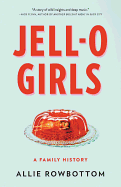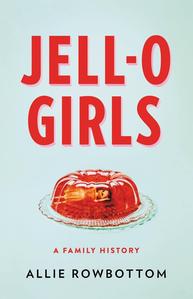
 "We come from Jell-O," writes Allie Rowbottom in Jell-O Girls, her memoir detailing her family's intertwined legacy with "America's Most Famous Dessert." In 1899, her great-great-great uncle Orator Woodward bought the Jell-O patent for $450 (or $4,000 today). Twenty-six years later, the patent was sold for $67 million.
"We come from Jell-O," writes Allie Rowbottom in Jell-O Girls, her memoir detailing her family's intertwined legacy with "America's Most Famous Dessert." In 1899, her great-great-great uncle Orator Woodward bought the Jell-O patent for $450 (or $4,000 today). Twenty-six years later, the patent was sold for $67 million.Woodward's marketing and advertising savvy shaped the sugary, gelatinous product into one of the world's most successful brands. It's been served by generations of housewives keeping boxes of the stuff "stacked like bricks" in their pantries, and using company-produced Jell-O recipe booklets to create ubiquitous salads and colorful fruit-laden molds. The Woodwards' wealth transformed LeRoy, N.Y., where Jell-O was manufactured, "just down the street from Orator's house, the river outside the factory running colorful and sweet, changing color weekly depending on the flavor."
However, Jell-O stained more than the town's water. Some Woodward family members--especially Rowbottom's mother, Mary Jane Fussell--believed that their wealth was responsible for "the Jell-O curse," an explanation used for "all manner of familial misfortune." Many Woodwards suffered from some combination of mental and physical illnesses, abuse, alcoholism and financial ruin; several died by suicide. As a child, Mary lost her mother to cancer and endured repeated sexual abuse by a manipulative cousin and his friends. At 19, she was hospitalized in a psychiatric center and later, suffered from the same cancer that claimed her mother.
With candid and unflinching descriptions connecting the history of Jell-O, feminism and her mother's unpublished writings, Rowbottom makes a case that the curse wasn't physical, emotional or confined exclusively to their family. (Pearle Wait, the original holder of the Jell-O patent, went bankrupt shortly after the sale.) Instead, the curse was a repressive societal attitude "reflected by the messages about women and their worth that her family sold with each box of Jell-O." Even the product's advertising depicted women and girls conforming to expectations by fitting into a perfect mold and stifling their voices. A modern-day case in point: in 2011, when a group of popular girls from LeRoy suddenly experienced mysterious twitching and convulsions, doctors dismissed the girls' ailments as "conversion disorder" and pleas for attention.
Jell-O Girls is a fascinating family history combined with an examination of an iconic brand, one with double-sided messages of domesticity and nurturing that have influenced generations of women. By sharing her family's most personal tragedies, Rowbottom shows the interconnectivity among women and the continued need for amplification of their voices. --Melissa Firman, writer, editor and blogger at melissafirman.com
Shelf Talker: This captivating memoir connects a family "curse" to Jell-O, feminism and changing societal norms.

